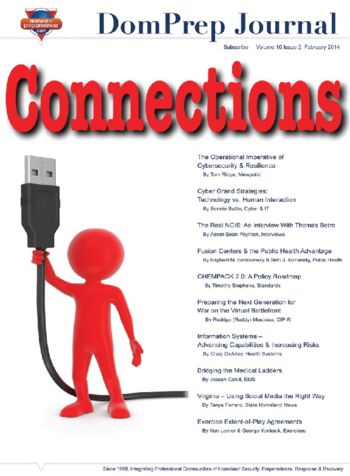
Author Archive

The Quadrennial Defense Review (QDR) is a legislatively mandated review of Department of Defense (DOD) strategy and priorities. The QDR will set a long-term course for DOD as it assesses the threats and challenges that the nation faces and rebalances DOD’s strategies, capabilities, and forces to address today’s conflicts and

EXTREMES
Domestic Preparedness
March 26, 2014
Featured in this issue: Natural Disasters: Challenges & Opportunities, By Stephen Grainer; Preparing for Extreme Weather Events, By Kay C. Goss; California – A Growing Response to Persistent Drought, By Mark Ghilarducci; Rising Waters & Tough Decisions, By Maggie Davis; Ten Winter Issues Every City Should Address, By Kim Fuller

Connections
Domestic Preparedness
February 26, 2014
Featured in this issue: The Operational Imperative of Cybersecurity & Resilience, By Tom Ridge; Cyber Grand Strategies: Technology vs. Human Interaction, By Bonnie Butlin; The Real NCIS: An Interview With Thomas Betro, By Aaron Sean Poynton; Fusion Centers & the Public Health Advantage, By Raphael M. Barishansky & Seth J.

Critical Infrastructure Protection: More Comprehensive Planning Would Enhance the CyberSecurity of Public Safety Entities’ Emerging Technology
Domestic Preparedness
February 3, 2014
The U.S. Government Accountability Office (GAO) reviewed the federal government’s level of coordination with state and local governments on cybersecurity concerns at emergency operations centers, public safety answering points, and first responder organizations involved in handling 911 emergency calls. This report provides insight to what the GAO found and recommends.

Farm to Fork
Domestic Preparedness
January 29, 2014
Featured in this issue: Call for Help – Defending the Food Supply, By Amy Kircher; Food Processors – Recovery Before a Recall, By Wm. Mark Cosby; Checklists for All-Hazards Food Defense Planning, By Kay C. Goss; Protecting the Food Supply Outside the Walls, By Don Hsieh; “Game Day” Food Defense:

CHOICES
Domestic Preparedness
December 25, 2013
Featured in this issue: Security Technology Trends to Watch in 2014, By Jay Hauhn; The Future of Training: Integrated, Intuitive & Interactive, By Craig Crume; Community Resilience & Functional Needs, By Marko Bourne; Reducing Risk, Building Resilience, By Sherri Goodman & Gretchen Hund; Resilience 2013 – Survey & Report, By

Food Defense
Domestic Preparedness
December 1, 2013
Food, like water and air, is essential to sustain life. As such, when someone deliberately taints that sustenance at any point in the food supply chain, the result can be devastating. This report addresses the topic of food defense, which is of great importance to the preparedness community, but it

Bio-Training
Domestic Preparedness
November 27, 2013
Featured in this issue: Black Swans – Preparing for Pandemic & Biological Threats, By Robert C. Hutchinson; Needed: More Biothreat Training for First Responders, By Steven P. Bucci & Jennifer Corrente-Bucci; Redirecting Dual-Use Research Regulations, By Courtney Gavitt; Emergency Management & Public Health: Partners in Preparedness, By Kay C. Goss;

Post-Disaster Reunification of Children: A Nationwide Approach
Domestic Preparedness
November 12, 2013
Post-Disaster Reunification of Children: A Nationwide Approach illustrates the significance of whole-community collaboration and inclusive emergency planning by providing a comprehensive overview of the coordination processes needed to reunify children separated from their parents or legal guardians in the event of a large-scale disaster. The report also discusses how the

GPS Disruptions: Efforts to Assess Risks to Critical Infrastructure and Coordinate Agency Actions Should Be Enhanced
Domestic Preparedness
November 10, 2013
The Government Accountability Office (GAO) was asked to review the effects of Global Positioning System (GPS) disruptions on the nation’s critical infrastructure. GAO examined: (a) the extent to which the U.S. Department of Homeland Security (DHS) has assessed the risks and potential effects of GPS disruptions on critical infrastructure; (b)
Follow Us
Get Instant Access
Subscribe today to Domestic Preparedness and get real-world insights for safer communities.
ARchives
Follow Us
Get Instant Access
Subscribe today to Domestic Preparedness and get real-world insights for safer communities.


